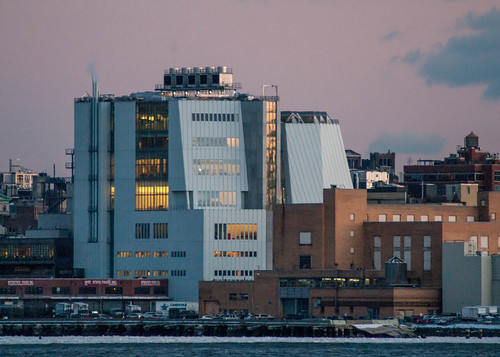The building was designed by Renzo Piano, a starchitect up there with Nouvel and Gehry (Flickr album). From the NYTimes, by Michael Kimmelman:
From the west, along the Hudson River, it looks ungainly and a little odd, vaguely nautical, bulging where the shoreline jogs, a ship on blocks perhaps, alluding to one of New York’s bedrock industries from long ago. It’s a glittery emblem of new urban capital, shipping now having gone the way of so much else in the neighborhood.
Yep.
The move confirms a definitive shift in the city’s social geography, which has been decades coming.
It ratifies Chelsea and the once-funky far West Village as something closer to what the Upper East Side used to be, say, circa 1966, the year Marcel Breuer’s Whitney building opened at 75th Street. Those neighborhoods serve up the same cocktail of money, real estate, fashion and art — except that the financiers, Hollywood stars and other haute bourgeois bohemians stand in for the old Social Register crowd.
Take that, Met and MOMA!
Continuing on:
The museum’s arrival signals another shift, too. When Breuer’s Whitney opened, New York City was a much dicier proposition. His fortress, like Frank Lloyd Wright’s Guggenheim Museum several blocks north — which contrived its own enclosed, spiral version of a vertical city — reflected ambivalence about what was outside the front door.
Now New York is a safe, glamorous tourist mecca and 24-hour, family-friendly spectacle, and the new $422 million Whitney building, designed by Renzo Piano, opening May 1, lets the city pour in. Grand, columnless, rectangular galleries spill onto large, stepped terraces linked by an outdoor stairway, mimicking the neighborhood’s jumble of low- and mid-rise black-tar rooftops and aging fire escapes. The museum becomes an implicit extension of the High Line: an outdoor perch to see and be seen.

No comments:
Post a Comment